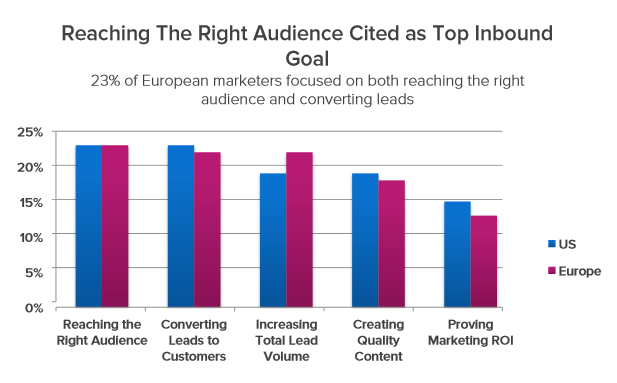An Insider's View: Inbound Marketing in Europe Versus the U.S.
An Insider's View: Inbound Marketing in Europe Versus the U.S.:
from HubSpot's Inbound Internet Marketing Blog
 At the launch of HubSpot’s European office in Dublin in March, my colleagues here at Brightfire shared some insights from a few of our customers on what it’s like to do inbound marketing in Europe -- because, well, it's a bit different than in the U.S.
At the launch of HubSpot’s European office in Dublin in March, my colleagues here at Brightfire shared some insights from a few of our customers on what it’s like to do inbound marketing in Europe -- because, well, it's a bit different than in the U.S.
In this blog post, I wanted to continue that discussion by sharing our view of some key differences between inbound marketing in Europe versus inbound marketing in the U.S. -- this time drawing on data from HubSpot’s 2013 State of Inbound Europe Report 2013, along with what our clients have experienced.
1) Inbound marketing is growing just as quickly in Europe as in the U.S.
This may come as a surprise, as there's often a misconception that inbound marketing in Europe is 12-18 months behind the U.S. According to the 2013 State of Inbound Marketing Europe Report, however, inbound marketing is growing at an impressive rate in Europe. Nearly 60% of companies are already practicing inbound marketing and 42% are set to increase their inbound marketing spending in 2013.Customer buying behavior has changed in Europe in exactly the same way as the U.S. Leads and customers research online, view websites, consume content, and actively engage on social media -- so it's no wonder that inbound marketing is catching on fast with marketers.
Though more and more marketers are adopting inbound marketing, our clients think there is still work to be done in the UK and Europe to make the inbound marketing concept clearer to businesses looking to engage customers online. Clients have also stressed the importance of an inbound strategy that aligns all online marketing practices with business goals.
2) Inbound marketing enjoys slightly higher internal support in Europe than it does in the U.S.
The 2013 State of Inbound Marketing Europe Report also found that the rate of internal support for inbound marketing in Europe is actually extremely high. 36% of respondents confirmed that inbound is completely integrated with their marketing strategy -- 1% higher than the U.S. number. Further, 44% answered that inbound is somewhat integrated. This means that 4 of 5 European marketers have at least somewhat integrated their inbound campaigns with larger marketing goals.How have European marketers been able to get this internal support? They've had the benefit of being able to observe the early adoption of inbound marketing in the U.S. As a result, they are able to put data in front of their executive sponsors that drives buy-in. Our clients have found that once co-workers understand inbound marketing as a holistic approach, then there is higher likelihood of internal support.
Because many European are enjoying the benefit of internal buy-in for inbound marketing strategies, there's a tremendous opportunity to gain more clarity around the areas of inbound where European marketers are particularly weak. For instance, many European inbound marketers struggle to prove ROI -- 1 in 4 report concern around proving ROI for their inbound activities. Later on we'll discuss their troubles with A/B testing and lead nurturing, too. Solving these problems will be easier when internal stakeholders are already bought in to the inbound marketing philosophy.
3) European inbound marketers are still predominantly focused on growing the top of the funnel, whereas U.S. inbound marketers have a more developed approach to lead nurturing.
We also found that the top priorities for European marketers look very similar to those of the U.S. 23% of those surveyed said that “reaching the right audience” was their most important priority, followed closely by converting more leads to customers.
However, European marketers might still consider investing more in developing their lead nurturing programs to make the most out of their concerted content creation and top-of-the-funnel efforts. With even more resources for content creation required than their U.S. counterparts, wringing the most ROI out of the leads generated with a nurturing program will make their efforts more cost-efficient.
4) European marketers don't align with their sales teams as well as U.S. marketers align with their sales teams.
In the same report, we found that even though European marketers are setting the right kind of priorities and metrics to measure their team’s success, there is still evidence of a Marketing-Sales divide in most companies. Only 22% of European firms had a formal agreement between Sales and Marketing -- 3% lower than the U.S. figure of 25%.While a formal agreement between Sales and Marketing isn’t always in place, we work hard with our clients to build Sales and Marketing alignment and have found this to be a vital component of their success with inbound marketing. Some of the building blocks for alignment are: executive sponsorship, Sales involvement in defining a Marketing Qualified Lead (MQL), participation in content promotion (e.g. sales executives sharing the company's latest blog posts on their own LinkedIn account), and feedback to Marketing on the quality of MQL.
5) European marketers don’t test their inbound strategies as much as their U.S. counterparts.
European marketers are also a little behind the U.S. in website optimization adoption. Only 25% of marketers in Europe are doing some form of testing -- either A/B tests or multivariate -- as part of their inbound strategy. Further, 49% of European marketers reported not testing at all, a rate 5% worse than the U.S.This testing delta may explain why the U.S.’s website conversion rates are nearly double European rates -- a 10.7% average vs. Europe’s 5.7%.
In almost every discussion we have with our prospects and customers, I've found they have an unrealistic view of what conversion rates they can achieve. This seems to be based on a lack of appreciation of the effort required to drive up and maintain the kinds of rates reported in the U.S. Testing is clearly a key factor in this, but our best-performing clients acknowledge the importance of revisiting and refining their personas' buying journeys. Such refinement is not possible without accurate testing data married to insight into the personas’ real issues.
We have an opportunity to grow conversation rates in many ways -- it's simply up to us to begin using the tools we have and experimenting a bit more.
Johnny Mone is the VP of Business Development at Brightfire, which specializes in B2B technology marketing. They are one of the longest-serving and most successful HubSpot partners in Europe.
Image credit: GlasgowAmateur




No comments:
Post a Comment